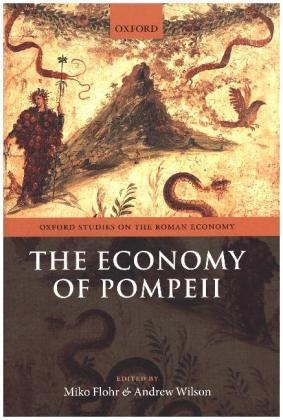Read more
Zusatztext The quality of these papers is very high, and the standard is maintained in this latest fascinating 14-paper volume. Informationen zum Autor Miko Flohr is postdoctoral researcher and lecturer at the Institute for History of Leiden University, and formerly assistant director of the Oxford Roman Economy Project. His main research focus lies with urban history in the Roman world, with a particular emphasis on economic issues in Roman Italy, and on textile economies. His first monograph, The World of the Fullo, was published with OUP in 2013; since, he has published on the textile economy of Pompeii, and on public investment in commercial space.Andrew Wilson is Professor of the Archaeology of the Roman Empire at All Souls College, University of Oxford. His research interests include the economy of the Roman empire, ancient technology, ancient water supply and usage, Roman North Africa, and archaeological field survey. Recent publications include: Quantifying the Roman Economy: Methods and Problems (ed. with Alan Bowman, Oxford, 2009), Settlement, Urbanization and Population (ed. with Alan Bowman, Oxford, 2011); The Roman Agricultural Economy: Organization, Investment, and Production (ed. with Alan Bowman, Oxford, 2013); Alexandria and the North-Western Delta (ed. with Damian Robinson, Oxford, 2010) and Maritime Archaeology and Ancient Trade in the Mediterranean (ed. with Damian Robinson, Oxford 2011). Klappentext This book is the first to address, from a variety of perspectives, the economy of the Roman city of Pompeii. It uses archaeological and textual evidence to discuss topics as diverse as agriculture in the fertile plains at the foot of mount Vesuvius, diet and health, manufacturing, urban investment, consumption, trade and money. Zusammenfassung This book is the first to address, from a variety of perspectives, the economy of the Roman city of Pompeii. It uses archaeological and textual evidence to discuss topics as diverse as agriculture in the fertile plains at the foot of mount Vesuvius, diet and health, manufacturing, urban investment, consumption, trade and money. Inhaltsverzeichnis Introduction: Investigating an Urban Economy Part I: City and Hinterland 1: Girolamo Ferdinando de Simone: The Agricultural Economy of Pompeii: Surplus and Dependence 2: Miko Flohr: Quantifying Pompeii: Population, Inequality, and the Urban Economy Part II: Quality of Life 3: Nick M. Ray: Consumer Behaviour in Pompeii: Theory and Evidence 4: Erica Rowan: Sewers, Archaeobotany, and Diet at Pompeii and Herculaneum 5: Estelle Lazer: Skeletal Remains and the Health of the Population at Pompeii Part III: Economic Life and its Contexts 6: Eric Poehler: Measuring the Movement Economy: A Network Analysis of Pompeii 7: Nicolas Monteix: Urban Production and the Pompeian Economy 8: Damian Robinson: Wealthy Entrepreneurs and the Urban Economy: Insula VI 1 in its Wider Economic Contexts 9: Domenico Esposito: The Economics of Pompeian Painting Part IV: Money and Trade 10: Steven J. R. Ellis: Reevaluating Pompeii's Coin -Finds: Monetary Transactions and Urban Rubbish in the Retail Economy of an Ancient City 11: Richard Hobbs: Bes, Butting Bulls, and Bars: The Life of Coinage at Pompeii 12: Koenraad Verboven: Currency and Credit in the Bay of Naples in the First Century ad 13: Wim Broekaert: Conflicts, Contract Enforcement, and Business Communities in the Archive of the Sulpicii Part V: Discussion 14: Willem Jongman: Pompeii Revisited ...

